Fluorescence Filters
Fluorescence optical devices rely on the fundamental role of fluorescence filters, which serve as the core elements within such devices. The production of high-quality filter sets is indispensable for achieving precise and sharp imaging as well as optimal performance in fluorescence microscopy applications. At Avantier, we specialize in crafting custom fluorescence filters that cater to diverse applications. Our offerings include filter cubes and filter wheels, both of which play pivotal roles in fluorescence microscopy.
Fluorescence Microscopy Unveiled
Fluorescence microscopes are ingeniously designed to detect the presence of fluorophores within a sample. These fluorophores can either be naturally occurring or intentionally introduced through dyes and labeling. A key principle underpinning their detection is the unique behavior exhibited by fluorophores: they absorb energy at specific wavelengths (known as the excitation range) and subsequently emit this energy at distinct wavelengths (referred to as the emission range). This distinctive behavior enables the identification of various fluorophores based on their absorption and emission characteristics.
Intriguingly, each type of fluorophore boasts its own individual excitation and emission spectra, each characterized by a specific peak wavelength. This distinctiveness grants us the ability to differentiate between fluorophores either through their excitation spectra, emission signals, or the interval between their peak excitation and emission wavelengths, known as the Stokes shift. This foundational principle forms the basis for all fluorescence microscopy systems, spanning from the straightforward epifluorescent microscope to the more intricate setups found in multiphoton systems.



The Essence of Fluorescence Optical Filter Sets
Central to the architecture of each fluorescence filter cube are three essential optical filters: the excitation filter, the dichroic mirror, and the emission filter.
- Excitation Filter (Exiter): This component, also known as the exiter, operates as a bandpass filter with the specific purpose of permitting only those wavelengths of light that are eagerly absorbed by the targeted fluorophore. Its role extends to minimizing undesired excitation from external light sources and other potential fluorescence sources. Furthermore, it effectively blocks any excitation wavelength light that falls within the fluorescence emission band. The brightness and brilliance of the final image are determined by the minimum transmission level of this filter. Generally, an excitation filter is considered adequate if it achieves a minimum transmission rate of 40%. For a well-lit and vivid image, a transmission rate exceeding 85% is recommended. The background darkness, as indicated by the optical density, should ideally reach a minimum of 3.0, preferably inching closer to 6.0. The excitation filter should be meticulously selected so that its center wavelength (CWL) closely aligns with the fluorophore’s peak excitation, while the bandwidth remains entirely encompassed within the fluorophore’s excitation range.
- Dichroic Mirror (Dichromatic Beamsplitter): Operating as a specialized edge filter, the dichroic mirror plays a vital role. Positioned at a 45-degree angle of incidence, it demonstrates the ability to reflect light within the excitation band’s wavelengths while concurrently transmitting light within the emission band. This arrangement ensures the smooth passage of light from the emitter to the detector, facilitating the desired optical outcomes.
- Emission Filter (Emitter): Serving as another crucial bandpass filter, the emitter filter exclusively permits the passage of light emitted by the fluorophore. It effectively blocks excitation light and all other extraneous light, spanning from ultraviolet to infrared wavelengths, thereby enhancing the accuracy and specificity of the emitted light’s detection.
In essence, the intricate interplay of these three fundamental filters within a fluorescence filter cube empowers fluorescence microscopes to precisely capture and discern fluorescent signals. This orchestrated synergy between excitation, transmission, and emission filters culminates in the creation of detailed and informative fluorescence microscopy imagery. At Avantier, our commitment to producing top-tier fluorescence optical filters ensures the realization of high-definition imaging and the advancement of fluorescence microscopy across various applications.

1. A fluorescence filter set includes an excitation filter, an emission filter, and a dichroic filter. The figure above shows the coating curves of an excitation filter designed for passing excitation range 480nm~ 500nm, emission filter designed for passing emission range 515nm ~ 545nm, and dichroic filter (i.e. long pass filter) designed for reflecting excitation wavelength and passing emission wavelength.

2. The figure above shows a transmission plot of an excitation filter which is a narrowband pass filter designed for passing excitation range 420nm~ 500nm and blocking the wavelength range 550nm ~1100nm.

Key Features
- High passband transmission (T>90%)
- Excellent blocking (OD>6.0)
- Hard coatings and no adhesives for long filter life
- All dielectric coated with IBS technology
Application
- Fluorescence microscope
- Co-localization fluorescence measurements
- Fluorescence In Situs Hybridization (FISH)
- Comparative Genomic Hybridization (CGH)
- Gel and spot Imaging comparisons
Factory Standards
Diameter: 18.0, 20.0, 22.0, 25.0mm |
Diameter Tolerance: +0/-0.1mm |
Passband Transmission: T>90% |
Clear Aperture: >80% |
Surface Quality: 60-40 |
Angle of Incidence: 0° +/- 5° |
Beam Deviation: <11 arc sec. |
Transmitted Wavefront: 1/4λRMS@633nm |
Operating Temperature: -45°C~85°C |
Environmental Durability: MIL-STD-810F |
Temperature Dependence: <5ppm/°C |
Blocking OD>6.0(typical): UV-700nm, λc<500nm UV-925nm, λc>500nm |
Physical Durability: MIL-C-48497A |
Substrate: Low Fluorescence BK7 or Equivalent |
Central Wavelength(nm) |
Bandwidth |
Transmission(%) |
Thickness(mm) |
Typical Application |
438 |
24 |
90% |
5.0 |
CEP Excitation |
447 |
60 |
90% |
3.5 |
DAPI Emission |
472 |
30 |
90% |
5.0 |
GFP Excitation |
482 |
35 |
90% |
5.0 |
FITC Excitation |
483 |
32 |
90% |
3.5 |
CFP Emission |
500 |
24 |
90% |
5.0 |
YFP Excitation |
510 |
84 |
90% |
3.5 |
FURA2 Emission |
520 |
35 |
90% |
3.5 |
GFP Emission |
531 |
40 |
90% |
5.0 |
CY3 Excitation |
536 |
40 |
90% |
3.5 |
FITC Emission |
542 |
27 |
90% |
3.5 |
YFP Emission |
543 |
22 |
90% |
5.0 |
TRITC Excitation |
562 |
40 |
90% |
5.0 |
Texas Red Excitation |
593 |
40 |
90% |
3.5 |
TRITC/CY3 Excitation |
624 |
40 |
90% |
3.5 |
Texas Red Emission |
628 |
40 |
90% |
5.0 |
SY5 Excitation |
692 |
40 |
90% |
3.5 |
SY5 Excitation |
438 |
24 |
90% |
5.0 |
CEP Excitation |
447 |
60 |
90% |
3.5 |
DAPI Emission |
Custom Fluorescence Filters
At Avantier we produce a wide range of fluorescence sets that are designed with the excitation and emission filters suitable for each commonly used fluorophore. For specialized applications, such as those using multiple fluorophores, alternate dichroic filters or laser sources, we are able to produce custom Fluorescence Filters sets upon request. Please contact us to discuss the specific requirements of your Custom Fluorescence Optical Filters project and to get a consultation and a price quote.
WE CAN HELP YOU!
Contact us NOW for sales & expert advice.





